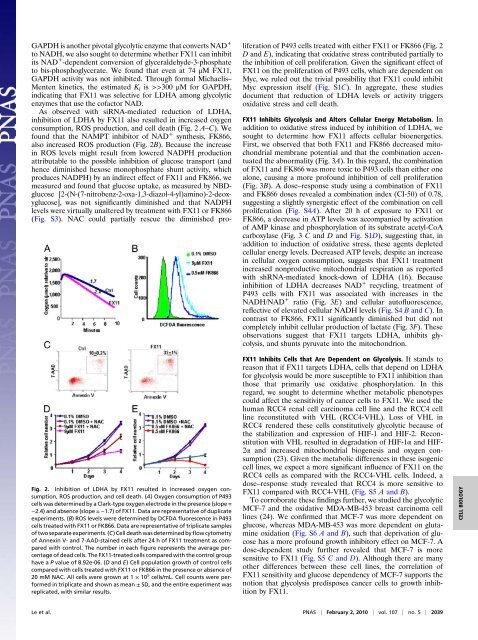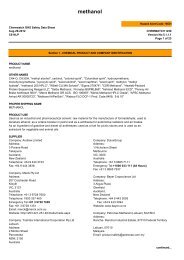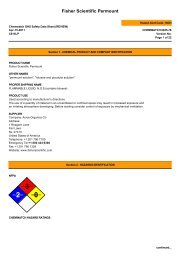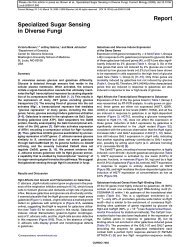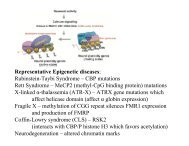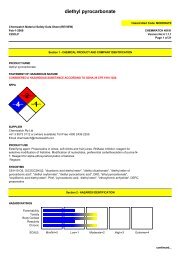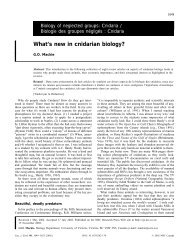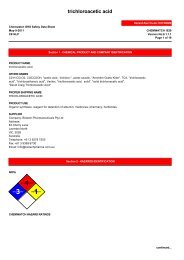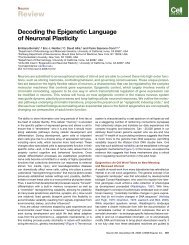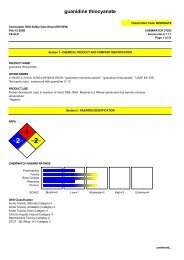Inhibition of lactate dehydrogenase A induces oxidative stress and ...
Inhibition of lactate dehydrogenase A induces oxidative stress and ...
Inhibition of lactate dehydrogenase A induces oxidative stress and ...
- No tags were found...
Create successful ePaper yourself
Turn your PDF publications into a flip-book with our unique Google optimized e-Paper software.
Fig. 2. <strong>Inhibition</strong> <strong>of</strong> LDHA by FX11 resulted in increased oxygen consumption,ROS production, <strong>and</strong> cell death. (A) Oxygen consumption <strong>of</strong> P493cells was determined by a Clark-type oxygen electrode in the presence (slope =−2.4) <strong>and</strong> absence (slope = −1.7) <strong>of</strong> FX11. Data are representative <strong>of</strong> duplicateexperiments. (B) ROS levels were determined by DCFDA fluorescence in P493cells treated with FX11 or FK866. Data are representative <strong>of</strong> triplicate samples<strong>of</strong> two separate experiments. (C) Cell death was determined by flow cytometry<strong>of</strong> Annexin V- <strong>and</strong> 7-AAD-stained cells after 24 h <strong>of</strong> FX11 treatment as comparedwith control. The number in each figure represents the average percentage<strong>of</strong> dead cells. The FX11-treated cells compared with the control grouphave a P value <strong>of</strong> 8.92e-06. (D <strong>and</strong> E) Cell population growth <strong>of</strong> control cellscompared with cells treated with FX11 or FK866 in the presence or absence <strong>of</strong>20 mM NAC. All cells were grown at 1 × 10 5 cells/mL. Cell counts were performedin triplicate <strong>and</strong> shown as mean ± SD, <strong>and</strong> the entire experiment wasreplicated, with similar results.GAPDH is another pivotal glycolytic enzyme that converts NAD +to NADH, we also sought to determine whether FX11 can inhibitits NAD + -dependent conversion <strong>of</strong> glyceraldehyde-3-phosphateto bis-phosphoglycerate. We found that even at 74 μM FX11,GAPDH activity was not inhibited. Through formal Michaelis–Menten kinetics, the estimated K i is >>300 μM for GAPDH,indicating that FX11 was selective for LDHA among glycolyticenzymes that use the c<strong>of</strong>actor NAD.As observed with siRNA-mediated reduction <strong>of</strong> LDHA,inhibition <strong>of</strong> LDHA by FX11 also resulted in increased oxygenconsumption, ROS production, <strong>and</strong> cell death (Fig. 2 A–C). Wefound that the NAMPT inhibitor <strong>of</strong> NAD + synthesis, FK866,also increased ROS production (Fig. 2B). Because the increasein ROS levels might result from lowered NADPH productionattributable to the possible inhibition <strong>of</strong> glucose transport (<strong>and</strong>hence diminished hexose monophosphate shunt activity, whichproduces NADPH) by an indirect effect <strong>of</strong> FX11 <strong>and</strong> FK866, wemeasured <strong>and</strong> found that glucose uptake, as measured by NBDglucose[2-(N-(7-nitrobenz-2-oxa-1,3-diazol-4-yl)amino)-2-deoxyglucose],was not significantly diminished <strong>and</strong> that NADPHlevels were virtually unaltered by treatment with FX11 or FK866(Fig. S3). NAC could partially rescue the diminished proliferation<strong>of</strong> P493 cells treated with either FX11 or FK866 (Fig. 2D <strong>and</strong> E), indicating that <strong>oxidative</strong> <strong>stress</strong> contributed partially tothe inhibition <strong>of</strong> cell proliferation. Given the significant effect <strong>of</strong>FX11 on the proliferation <strong>of</strong> P493 cells, which are dependent onMyc, we ruled out the trivial possibility that FX11 could inhibitMyc expression itself (Fig. S1C). In aggregate, these studiesdocument that reduction <strong>of</strong> LDHA levels or activity triggers<strong>oxidative</strong> <strong>stress</strong> <strong>and</strong> cell death.FX11 Inhibits Glycolysis <strong>and</strong> Alters Cellular Energy Metabolism. Inaddition to <strong>oxidative</strong> <strong>stress</strong> induced by inhibition <strong>of</strong> LDHA, wesought to determine how FX11 affects cellular bioenergetics.First, we observed that both FX11 <strong>and</strong> FK866 decreased mitochondrialmembrane potential <strong>and</strong> that the combination accentuatedthe abnormality (Fig. 3A). In this regard, the combination<strong>of</strong> FX11 <strong>and</strong> FK866 was more toxic to P493 cells than either onealone, causing a more pr<strong>of</strong>ound inhibition <strong>of</strong> cell proliferation(Fig. 3B). A dose–response study using a combination <strong>of</strong> FX11<strong>and</strong> FK866 doses revealed a combination index (CI-50) <strong>of</strong> 0.78,suggesting a slightly synergistic effect <strong>of</strong> the combination on cellproliferation (Fig. S4A). After 20 h <strong>of</strong> exposure to FX11 orFK866, a decrease in ATP levels was accompanied by activation<strong>of</strong> AMP kinase <strong>and</strong> phosphorylation <strong>of</strong> its substrate acetyl-CoAcarboxylase (Fig. 3 C <strong>and</strong> D <strong>and</strong> Fig. S1D), suggesting that, inaddition to induction <strong>of</strong> <strong>oxidative</strong> <strong>stress</strong>, these agents depletedcellular energy levels. Decreased ATP levels, despite an increasein cellular oxygen consumption, suggests that FX11 treatmentincreased nonproductive mitochondrial respiration as reportedwith shRNA-mediated knock-down <strong>of</strong> LDHA (16). Becauseinhibition <strong>of</strong> LDHA decreases NAD + recycling, treatment <strong>of</strong>P493 cells with FX11 was associated with increases in theNADH/NAD + ratio (Fig. 3E) <strong>and</strong> cellular aut<strong>of</strong>luorescence,reflective <strong>of</strong> elevated cellular NADH levels (Fig. S4 B <strong>and</strong> C). Incontrast to FK866, FX11 significantly diminished but did notcompletely inhibit cellular production <strong>of</strong> <strong>lactate</strong> (Fig. 3F). Theseobservations suggest that FX11 targets LDHA, inhibits glycolysis,<strong>and</strong> shunts pyruvate into the mitochondrion.FX11 Inhibits Cells that Are Dependent on Glycolysis. It st<strong>and</strong>s toreason that if FX11 targets LDHA, cells that depend on LDHAfor glycolysis would be more susceptible to FX11 inhibition thanthose that primarily use <strong>oxidative</strong> phosphorylation. In thisregard, we sought to determine whether metabolic phenotypescould affect the sensitivity <strong>of</strong> cancer cells to FX11. We used thehuman RCC4 renal cell carcinoma cell line <strong>and</strong> the RCC4 cellline reconstituted with VHL (RCC4-VHL). Loss <strong>of</strong> VHL inRCC4 rendered these cells constitutively glycolytic because <strong>of</strong>the stabilization <strong>and</strong> expression <strong>of</strong> HIF-1 <strong>and</strong> HIF-2. Reconstitutionwith VHL resulted in degradation <strong>of</strong> HIF-1α <strong>and</strong> HIF-2α <strong>and</strong> increased mitochondrial biogenesis <strong>and</strong> oxygen consumption(23). Given the metabolic differences in these isogeniccell lines, we expect a more significant influence <strong>of</strong> FX11 on theRCC4 cells as compared with the RCC4-VHL cells. Indeed, adose–response study revealed that RCC4 is more sensitive toFX11 compared with RCC4-VHL (Fig. S5 A <strong>and</strong> B).To corroborate these findings further, we studied the glycolyticMCF-7 <strong>and</strong> the <strong>oxidative</strong> MDA-MB-453 breast carcinoma celllines (24). We confirmed that MCF-7 was more dependent onglucose, whereas MDA-MB-453 was more dependent on glutamineoxidation (Fig. S6 A <strong>and</strong> B), such that deprivation <strong>of</strong> glucosehas a more pr<strong>of</strong>ound growth inhibitory effect on MCF-7. Adose-dependent study further revealed that MCF-7 is moresensitive to FX11 (Fig. S5 C <strong>and</strong> D). Although there are manyother differences between these cell lines, the correlation <strong>of</strong>FX11 sensitivity <strong>and</strong> glucose dependency <strong>of</strong> MCF-7 supports thenotion that glycolysis predisposes cancer cells to growth inhibitionby FX11.CELL BIOLOGYLe et al. PNAS | February 2, 2010 | vol. 107 | no. 5 | 2039


